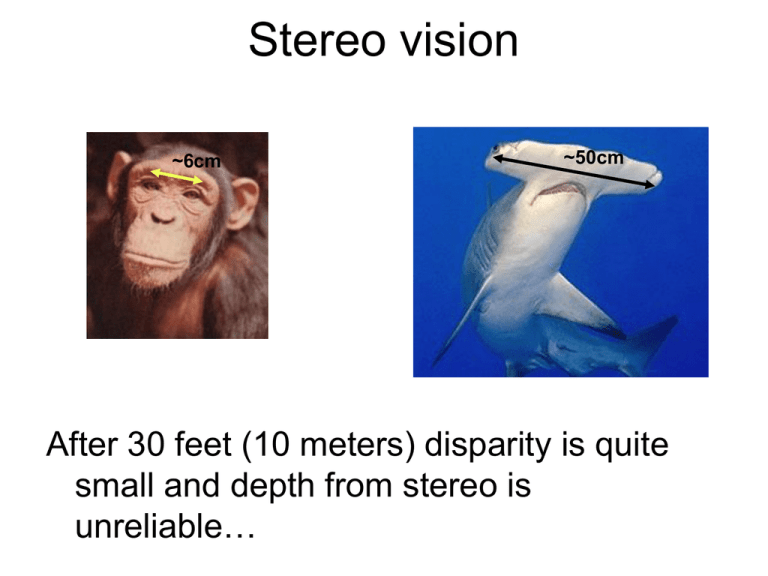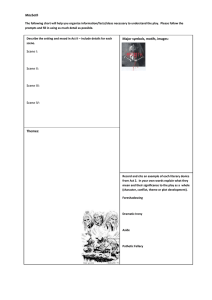3D Perception
advertisement

Stereo vision ~6cm ~50cm After 30 feet (10 meters) disparity is quite small and depth from stereo is unreliable… Monocular cues to depth • Absolute depth cues: (assuming known camera parameters) these cues provide information about the absolute depth between the observer and elements of the scene • Relative depth cues: provide relative information about depth between elements in the scene (this point is twice as far at that point, …) Texture Gradient A Witkin. Recovering Surface Shape and Orientation from Texture (1981) Illumination • Shading • Shadows • Inter-reflections Shading • Based on 3 dimensional modeling of objects in light, shade and shadows. • Perception of depth through shading alone is always subject to the concave/convex inversion. The pattern shown can be perceived as stairsteps receding towards the top and lighted from above, or as an overhanging structure lighted from below. Shadows Slide by Steve Marschner: is the ball on the ground or off? http://www.cs.cornell.edu/courses/cs569/2008sp/schedule.stm Shadows The moving shadow cue is also simple: the farther a shadow moves from the object casting it, the farther the object is from the background. http://vision.psych.umn.edu/users/kersten/kersten-lab/shadows.html Linear Perspective Based on the apparent convergence of parallel lines to common vanishing points with increasing distance from the observer. (Gibson : “perspective order”) In Gibson’s term, perspective is a characteristic of the visual field rather than the visual world. It approximates how we see (the retinal image) rather than what we see, the objects in the world. Perspective : a representation that is specific to one individual, in one position in space and one moment in time (a powerful immediacy). Is perspective a universal fact of the visual retinal image ? Or is perspective something that is learned ? Simple and powerful cue, and easy to make it work in practice… Linear Perspective Ponzo’s illusion Both horizontal yellow lines are the same size, but one appears to be longer Than the other. Linear Perspective Muller-Lyer 1889 Linear Perspective Muller-Lyer 1889 Linear Perspective Muller-Lyer 1889 Linear Perspective (c) 2006 Walt Anthony The red line at the end is 5 tiles, but the one in front is only one 3D drives perception of important object attributes These two pictures of the Leaning Tower of Pisa look as if they have been photographed from a different angle, but in fact they are identical. This is an example of a visual rather than optical illusion, because the trick is in the mind, not in the light. Why does it happen? Normally, when two identical towers rise up, their images converge due to perspective. Our brains have learnt to compensate for the perspective distortion with the result that we see the towers correctly as identical. However when the image contains towers that do not converge but are instead parallel, as in the Pisa towers, the visual system, because it applies the same perspective correction, sees them as diverging. The two Towers of Pisa Frederick Kingdom, Ali Yoonessi and Elena Gheorghiu of McGill Vision Research unit. Atmospheric perspective • Based on the effect of air on the color and visual acuity of objects at various distances from the observer. • Consequences: – Distant objects appear bluer – Distant objects have lower contrast. Atmospheric perspective http://encarta.msn.com/medias_761571997/Perception_(psychology).html Claude Lorrain (artist) French, 1600 - 1682 Landscape with Ruins, Pastoral Figures, and Trees, 1643/1655 Absolute (monocular) depth cues Are there any monocular cues that can give us absolute depth from a single image? Familiar size Which “object” is closer to the camera? How close? Familiar size Apparent reduction in size of objects at a greater distance from the observer Size perspective is thought to be conditional, requiring knowledge of the objects. But, material textures also get smaller with distance, so possibly, no need of perceptual learning ? Perspective vs. familiar size 3D percept is driven by the scene, which imposes its ruling to the objects Scene vs. objects What do you see? A big apple or a small room? I see a big apple and a normal room The scene seems to win again? [The Listening Room Rene Magritte] Scene vs. objects [Personal Values Rene Magritte] The importance of the horizon line Distance from the horizon line • Based on the tendency of objects to appear nearer the horizon line with greater distance to the horizon. • Objects approach the horizon line with greater distance from the viewer. The base of a nearer column will appear lower against its background floor and further from the horizon line. Conversely, the base of a more distant column will appear higher against the same floor, and thus nearer to the horizon line. Relative height the object closer to the horizon is perceived as farther away, and the object further from the horizon is perceived as closer If you know camera parameters: height of the camera, then we know real depth Object Size in the Image Image World Slide by Derek Hoiem Slide by Aude Oliva Slide by Aude Oliva Textured surface layout influences depth perception The segmentation and regions are the same, the percept is totally different: by exposures to a lot of images, we learnt that a specific distribution of features is correlated with a volume. The interpretation of objects is different: sky and water, reflection and trees, bracnhes, rocks Torralba & Oliva (2002, 2003) Slide by Aude Oliva Depth Perception from Image Structure Holes rocks We got wrong: • 3D shape (mainly due to assumption of light from above) • The absolute scale (due to the wrong recognition). Depth Perception from Image Structure Mean depth refers to a global measurement of the mean distance between the observer and the main objects and structures that compose the scene. Stimulus ambiguity: the three cubes produce the same retinal image. Monocular information cannot give absolute depth measurements. Only relative depth information such as shape from shading and junctions (occlusions) can be obtained. Depth Perception from Image Structure However, nature (and man) do not build in the same way at different scales. d3 d2 d1 If d1>>d2>>d3 the structures of each view strongly differ. Structure provides monocular information about the scale (mean depth) of the space in front of the observer. Statistical Regularities of Scene Volume When increasing the size of the space, natural environment structures become larger and smoother. Evolution of the slope of the global magnitude increases withspectrum increasing For man-made environments, the clutter of the scene distance: close-up views on objects have large and homogeneous regions. When increasing the size of the space, the scene “surface” breaks down in smaller pieces (objects, walls, windows, etc). Torralba & Oliva. (2002). Depth estimation from image structure. IEEE Pattern Analysis and Machine Intelligence Slide by Aude Oliva Image Statistics and Scene Scale Close-up views Large scenes On average, low clutter On average, highly cluttered Point view is unconstrained Point view is strongly constrained Image Scale vs. Scene Scale It is not all about objects 3D percept is driven by the scene, which imposes its ruling to the objects Class experiment Class experiment Experiment 1: draw a horse (the entire body, not just the head) in a white piece of paper. Do not look at your neighbor! You already know how a horse looks like… no need to cheat. Class experiment Experiment 2: draw a horse (the entire body, not just the head) but this time chose a viewpoint as weird as possible. 3D object categorization Wait: object categorization in humans is not invariant to 3D pose 3D object categorization Despite we can categorize all three pictures as being views of a horse, the three pictures do not look as being equally typical views of horses. And they do not seem to be recognizable with the same easiness. by Greg Robbins Observations about pose invariance in humans Two main families of effects have been observed: • Canonical perspective • Priming effects Canonical Perspective Experiment (Palmer, Rosch & Chase 81): participants are shown views of an object and are asked to rate “how much each one looked like the objects they depict” (scale; 1=very much like, 7=very unlike) 5 2 From Vision Science, Palmer Canonical Perspective Examples of canonical perspective: In a recognition task, reaction time correlated with the ratings. Canonical views are recognized faster at the entry level. Why? From Vision Science, Palmer Explicit 3D model Object Recognition in the Geometric Era: a Retrospective, Joseph L. Mundy




